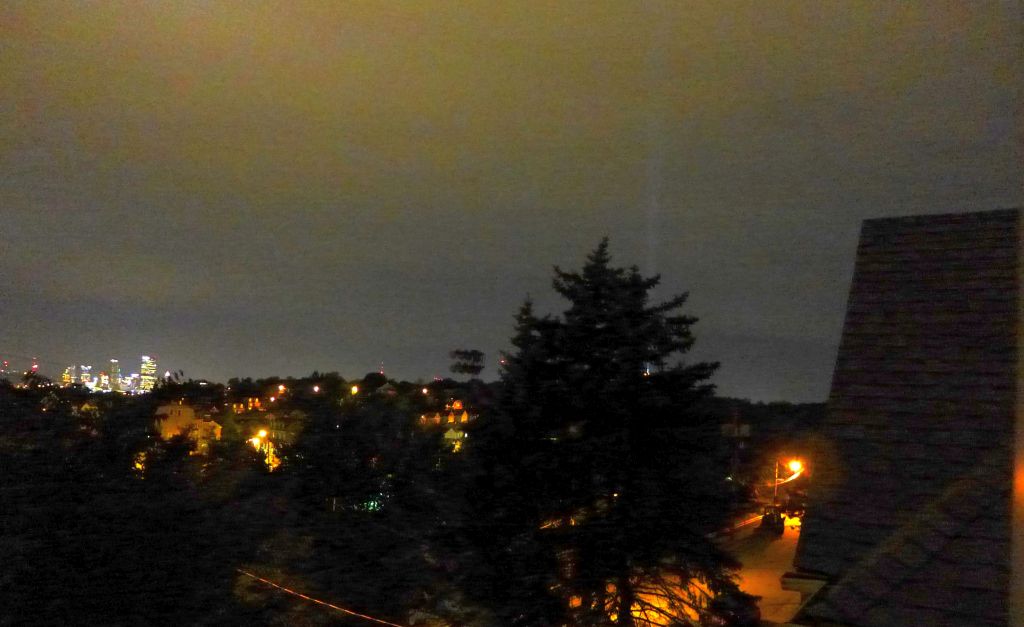
For migrating songbirds there are two deadly attractions in this photo.
On the left, Downtown Pittsburgh glows in the distance illuminating the night sky. At center-right, Pitt’s blue Victory Lights beam up from the Cathedral of Learning roof. (The building itself is hidden by the dark spruce.)
Downtown Pittsburgh glows every night. Pitt’s Victory Lights glow on Saturday and Sunday nights after Pitt wins a football game. Photographer Dave DiCello tweeted his photo, below, of the Victory Lights on 15 September after Pitt beat Georgia Tech.
The moon shines beside the Cathedral of Learning tonight, as the Victory Lights and spotlights from the roof illuminate the sky over #Pittsburgh in celebration of Pitt’s first ACC win of the season pic.twitter.com/SuTRzRVpl9
— Dave DiCello (@DaveDiCello) September 16, 2018
City lights are a fatal attraction for songbirds because they migrate at night using celestial lights for navigation. Lured by artificial lights they become confused and circle them. Some crash into buildings. Others land in the city and try to leave after dawn but mistake glass reflections of trees and sky for the real thing. They fly headfirst into glass buildings and windows. Some are stunned, 54% to 76% die. Warblers and wood thrushes are especially vulnerable. Every year nearly half a billion birds die this way in the U.S.
You can help birds survive Pittsburgh’s bright lights, both now and in the future. Jon Rice at BirdSafe Pittsburgh is mobilizing volunteers to help stunned birds now and to collect data on deaths to mitigate the future.
Here’s what you can do:
- Report Dead Birds: If you find a dead bird pause to report it. Enter what, where and when in BirdSafe’s I Found A Bird online tool. Your smartphone automatically knows “where.”
- Volunteer with BirdSafe: Walk a route for BirdSafe to rescue stunned birds and collect the dead ones(*). See the BirdSafe Volunteer page for more information. Contact BirdSafe here.
A 10 September 2018 op-ed in the New York Times by Andrew Farnsworth and Kyle G. Horton explains how the 9/11 Tribute of Light made an easy change that solved this problem.

After the Tribute began in 2003, people noticed that thousands of birds were lured to the lights and dying there, so in 2005 New York City Audubon mobilized volunteers to monitor the beams. When volunteers count 1,000 birds circling in the beams or if a bird is found dead, the lights are turned off for 20 minutes. That’s all it takes for the “stuck” birds to resume their migration and not become trapped again. Since 2005 only two birds have died during the Tribute of Light!
The article also describes how we can apply this knowledge across the U.S., including in Pittsburgh.
We also discovered that on average, half of the total passage of autumn bird migration density over the continental United States occurs on fewer than 10 nights. With migration forecasts developed by scientists at the Cornell Lab, the University of Massachusetts at Amherst and Oxford University, these cities and others could determine the optimal nights to dim or extinguish lights so that birds can pass safely.
(from Farnsworth and Horton New York Times 9/10/2018 op-ed)
This easy solution will save migrating birds but we need the data to convince others to make it happen. Please help the birds by helping BirdSafe Pittsburgh.
(photo credits: Downtown Pittsburgh and Pitt Victory Lights by Kate St. John. Cathedral of Learning and Pitt Victory Lights embedded tweet by Dave DiCello. 9/11 Tribute of Light from Wikimedia Commons; click on the caption to see the original)
(*) The dead birds are valuable for science. They become part of the Carnegie Museum of Natural History’s collection.
Light pollution and Science Center???
Pitt does a lot of a**-backward or I should say non-scientific behavior. When I was still working there, a swarm of bees settled on a doorjam across the alley from the back of Forbes Pavilion. Instead of handling it properly, after 24 hours, someone, in their wisdom, sprayed all the bees with Raid. I thought,”What good does it do to work in a scientific community if people are going to behave like that!”